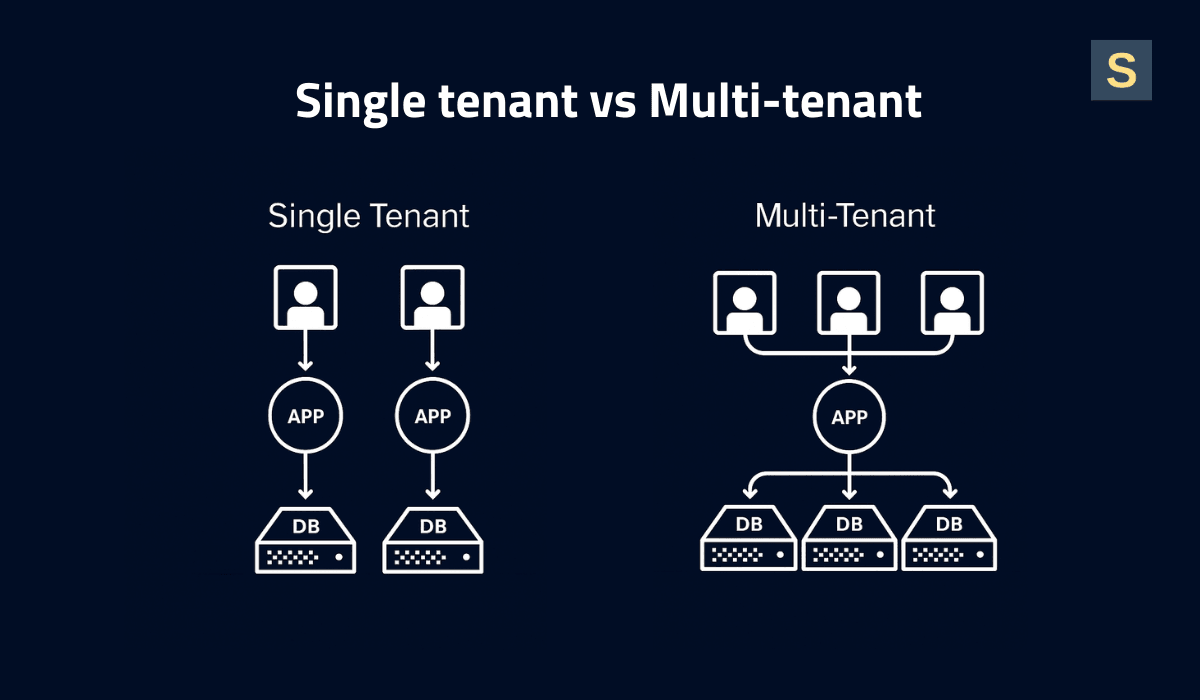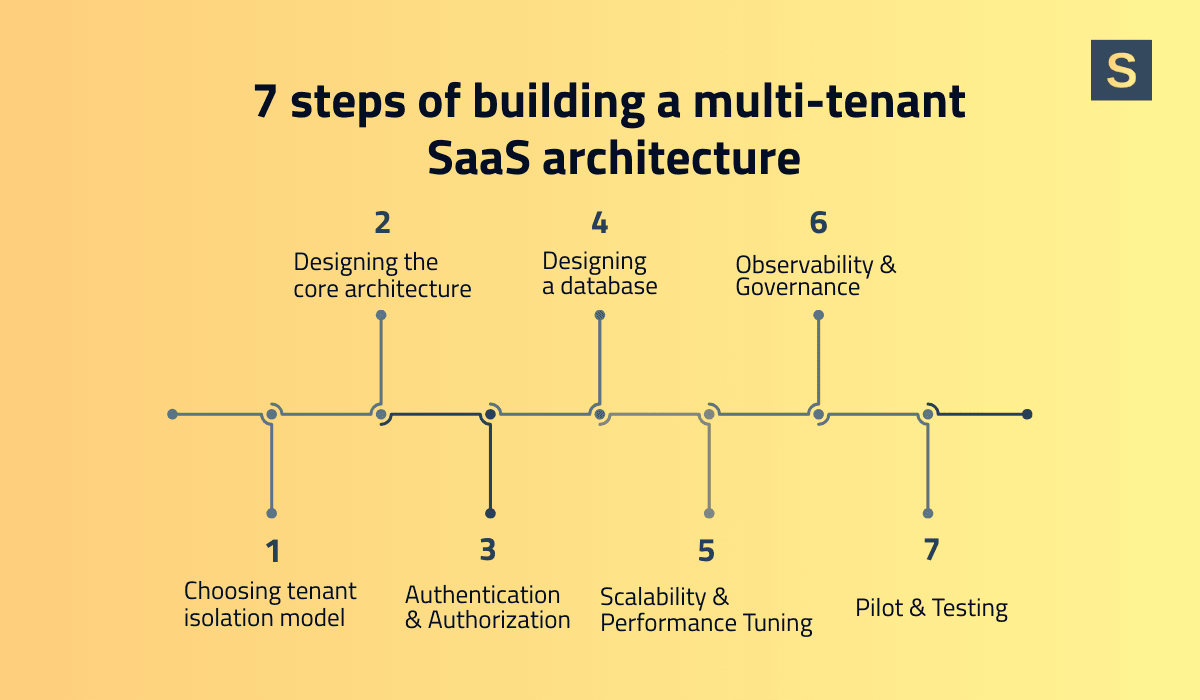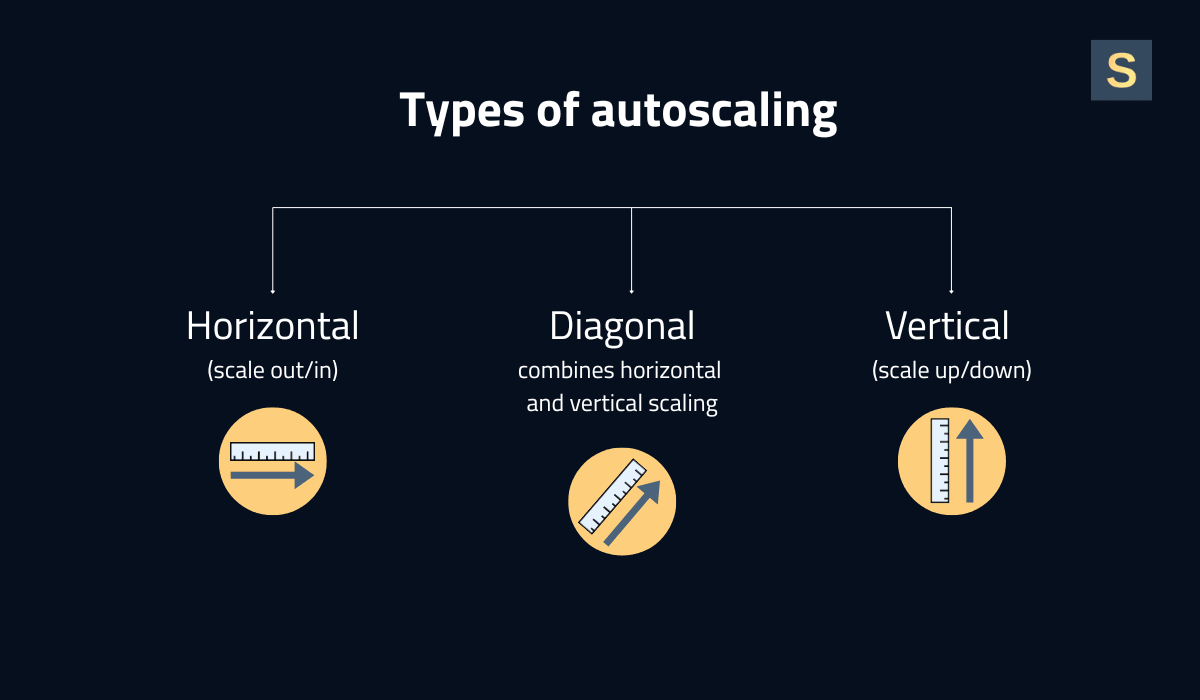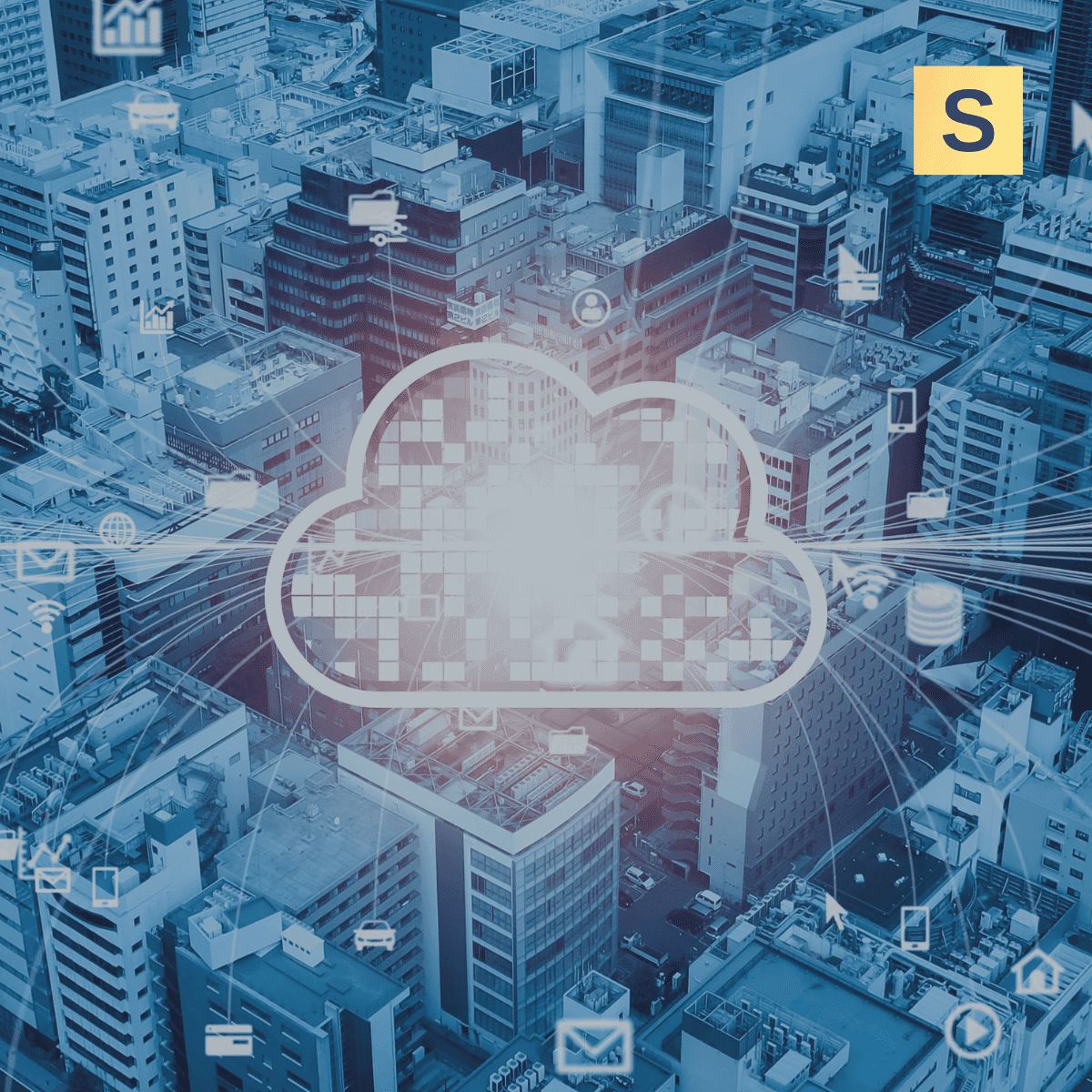Building scalable SaaS applications is no easy feat, especially if they must securely support multiple customers (tenants) on a shared platform. With over eight years of experience in SaaS product development, we understand the common pitfalls that tech leaders face.
In this article, we'll explore single-tenant vs multi-tenant trade-offs, guide you through designing efficient multi-tenant SaaS applications, and end with multi-tenant architecture best practices.
Multi-tenant vs. Single-tenant SaaS: Strategic Trade-offs
When building a SaaS application, you must choose an SaaS multi-tenant architecture type. Each model involves cost, security, customization, and scalability strategic trade-offs.

Single-Tenant Architecture
Each tenant operates in an isolated environment, like every client has their own house. This setup provides maximum data isolation and security, and allows for deep customizations per client since changes only impact their instance. However, single-tenancy is costly and more challenging to scale. With dedicated resources per tenant, infrastructure costs increase linearly with each customer.
Onboarding new clients means setting up new servers or containers, which raises complexity and deployment time. Additionally, the maintenance workload grows: updates or patches must be executed on every instance, which hampers release cycles.
It's a good solution for enterprises with strict security and compliance. Let's say you build custom HR software for a large corporation that requires dedicated infrastructure, tightly controlled data access and the ability to customize workflows.
Read also: How to Estimate SaaS Development Costs
Multi-Tenant Architecture
Multiple tenants coexist within a shared application and database, with logical segregation (typically a tenant ID column or isolated schema) ensuring the confidentiality of each tenant's data. Multi-tenancy is highly cost-efficient and scalable. Resources are pooled, so you’re not running 100 separate servers for 100 customers. Instead, a shared cluster handles all tenants.
New customers can be onboarded swiftly using the existing infrastructure, without complex setup. Maintenance is simpler, too, since there is a single codebase and deployment. Bug fixes and patches have to be applied once to accommodate each tenant. However, multi-tenancy introduces design complexity and necessitates robust security controls.
Performance may also be a challenge due to shared resources. This can cause a noisy neighbor problem, where one tenant consumes too many resources and affects others. To prevent this, you need to use resource management strategies such as load balancing, query limits, and throttling to keep the system fair.
Hybrid Methods
There are also hybrid approaches that combine the best of both worlds. For example, you might serve most customers within a shared multitenant environment, but provide dedicated instances for enterprise customers that need more security or performance guarantees. This vertical partitioning model allows you to achieve cost savings for most tenants while isolating only those who require it. Additionally, you can charge a premium for a single-tenant deployment option.
The trade-off is increased complexity. Your codebase must support both multi-tenant and single-tenant modes in parallel. You’ll also need clear processes to migrate a customer from the shared environment to a dedicated one (and vice versa) if their needs change. Aside from the added complexity, hybrid architectures are common for SaaS providers serving large enterprises and SMBs, or for offering tiered plans.
Building a Multi-tenant SaaS Architecture: 7 Key Steps
Most companies start off with a simple multi-tenant SaaS architecture and then evolve it as the tenant count goes up and requirements get harder to fulfill. Here’s a step-by-step overview of how we do it at Seedium.

1. Choose the Right Tenant Isolation Model
Tenant isolation is a key architectural decision. The main tenancy patterns include:
- Shared everything: all tenants have access to the same database/tables;
- Shared with logical partitions: for example, one database but separate schemas or tenant ID columns;
- Separate instances per tenant: each tenant has its own database or even its own deployment.
Your choice should balance security, compliance, performance, and cost. For instance, a small B2B SaaS with dozens of similar customers may use a shared database with tenant IDs (cost-effective and simple), while a SaaS serving a few large enterprises that handle sensitive data may opt for a database-per-tenant for maximum isolation. A hybrid approach is also possible: use a shared database for most tenants, migrating larger customers to separate databases as they grow.
2. Design the Core Architecture (Monolith vs. Microservices vs. Serverless)
The choice between monolithic vs microservice architectures is not straightforward. Microservices are often considered the most agile solution, but they are rarely needed from day one. In reality, for 99% of early-stage products, a properly architected monolith is optimal for simplicity and speed.
Monolithic architectures are simpler to develop and deploy initially, and can certainly handle high load if you scale them using best practices. Many SaaS platforms support millions of users on a monolith. Microservices are helpful as you scale or develop some parts of the system independently. However, they increase complexity in orchestration and require a mature DevOps culture to cope with.

We recommend starting with a monolithic or modular monolith to launch your product faster, then extract microservices for specific components as bottlenecks or organizational needs arise. On top of this, consider containerization (Docker/Kubernetes) or serverless functions for certain services.
For example, your core app could run as a containerized service, while serverless AWS Lambda functions handle isolated tasks such as image processing. This approach improves scalability and cost-efficiency for variable workloads.
Also, choose your cloud infrastructure carefully. Most SaaS providers use a public cloud like AWS, Google Cloud, or Azure in order to use on-demand scale and managed services.
Each cloud provider is adept at something. For example, AWS boasts an astronomical number of services and regions. See our AWS vs. Google Cloud for business guide for a complete comparison.
3. Use Robust Authentication & Authorization (Tenant-Aware Security)
Most SaaS platforms use an organization-based authentication model. Using Auth0 or another identity provider (IdP), each tenant can be represented as an organization, with users belonging to one or more organizations.
When it comes to security, Role-Based Access Control (RBAC) is the obvious access control mechanism to begin. Define roles (Admin, Editor, Viewer) scoped per-tenant, so one user can be an Admin in Tenant A but maybe only a Viewer in Tenant B. Your multi-tenant SaaS application should always enforce context: when a logged-in user makes a request, the system must ask "Does user X have permission Y in tenant Z? " before granting access. This prevents cross-tenant access even where multiple tenants have accounts.
As your SaaS grows, a future extension to Attribute-Based Access Control (ABAC) or relationship-based patterns may be required for finer granularity. Still, the basic principle is the same: each permission check is made with the tenant identifier.
Enterprise customers will also need features such as Single Sign-On (SSO) integration and possibly SCIM provisioning. Designing your auth to integrate with SSO providers (SAML, OAuth/OIDC) allows tenant organizations to connect their own Identity Providers (like Okta or Azure AD).
4. Design a Scalable Multi-Tenant Database
The database tier is often at the heart of multi-tenancy, and it's critical to get this right for performance and data isolation. You can choose from a variety of multi-tenant database design patterns:

- Shared Database, Shared Schema. All of the tenants' data resides in the same database tables, separated by a tenant ID column. It is easy and good for cost savings and high baseline scalability, as you deal with a single set of tables. But data isolation makes perfect sense: a query programming bug can leak data, and you have to be very strict with queries and perhaps even use row-level security policies.
- Shared Database, Individual Schemas. Multiple tenants share the same DB instance, yet each tenant has its own schema (i.e., its own collection of tables within the DB). This gives a moderate isolation level and allows for some customization, as one tenant's schema might include an additional table or slightly different indexes.
- Separate Database per Tenant. Each tenant has an independent database (or cluster), providing maximum isolation and security. Performance issues in one database do not affect others, and schema changes can be applied per tenant. However, this approach is resource-intensive and costly, potentially requiring N copies of the database for N tenants, which becomes expensive and harder to maintain at scale. This is feasible when serving only a few large tenants (e.g., 10 enterprise customers).
- Hybrid / Partitioned. A combination approach in which some tenants share databases while others have separate ones. For example, a database can be shared until it reaches X GB or Y tenants, after which data is sharded across multiple databases. Heavier-resource tenants can migrate to dedicated databases, while lighter tenants continue sharing.
5. Enable Scalability & Performance Tuning
To handle growing user volumes without system collapse, you need to build scalability into your infrastructure and software. This involves both auto-scaling and performance tuning:
- Auto-Scaling Infrastructure. Use cloud features to auto-scale out as load increases. For instance, in the case of containerized workloads on Kubernetes or ECS, use Horizontal Pod Autoscalers (HPA) to raise the number of pods when CPU or latency is over a certain threshold. With VM-based deployments, use auto-scaling groups to create more instances at high load. Serverless components will scale by themselves on demand, but keep their limits under control.

- Load Balancing & Tenant-Aware Routing. Put good load balancers in front of your services so that incoming requests get forwarded. In a multi-tenant setup, you might employ tenant-aware routing optimizations. For instance, route all requests for Tenant X to the same set of servers for cache locality, or restrict a VIP customer's traffic to an isolated node.
- Caching and CDN. Caching is critical for performance. Use in-memory caches (e.g., Redis or Memcached) to store frequently accessed data or computationally expensive query results per tenant. For instance, store tenant-specific configurations or analytics query results so subsequent users from the same organization receive faster responses. Employ a Content Delivery Network (CDN) to cache static assets and, where possible, dynamic responses at the edge.
Continuously monitor application performance metrics (latency, throughput, error rates) and break them down by tenant. This will help you pinpoint if a particular tenant is experiencing slowness. It also helps demonstrate to your customers that you meet your performance SLAs.
Before building scalable SaaS applications, we recommend you read our article on the key principles of scalable software architecture.
6. Add Observability & Governance for All Tenants
With your SaaS expanding to dozens or hundreds of tenants, the ability to observe what's happening and be in control becomes a must. Observability means having the right monitoring, logging, and tracing, while governance means being in charge of usage, compliance, and security on a per-tenant level.
You will need the following mechanisms:
- Per-Tenant Monitoring. Monitoring the system as a whole is not enough; you must instrument your app to measure per-tenant metrics. This can include tagging application metrics and logs with a tenant ID. As an example, monitor the volume of requests each tenant gets, their error rate, page load time, database query times by tenant, etc. With that data, you can create internal dashboards showing each tenant's experience health.
- Centralized Logging & Auditing. Implement a centralized logging system that collects logs across your multi-tenant SaaS architecture, including tenant context in each entry. This allows filtering by tenant activity and enables rapid debugging when a tenant reports an issue.
- Tenant Analytics & Usage Dashboards. Create internal dashboards that give your staff an overview of usage for each tenant: active users, API calls, storage consumed, etc. This helps with capacity planning (you can sometimes tell that one customer is going to need a dedicated node), as well as business decisions (identifying power consumers vs. low usage customers).
- FinOps and Chargeback. For overage or usage-based pricing, accurate per-tenant metering should feed into your billing system. Even without such pricing, it is advisable to maintain internal chargeback accounting, mapping cloud spending to individual tenants.
Treat observability and governance as first-class features of your SaaS. Day one, instrument your multi-tenant SaaS application with monitoring hooks and establish security baselines. It's far easier to build this in up front than to retrofit auditing and metering after you've achieved 100 customers.
7. Pilot Projects and Scale Test
Experiment with opening up with a pilot group of tenants or a beta environment and test against actual conditions. For example, on-board 2-3 nice customers onto the new system and observe everything closely. This enables you to make sure tenant onboarding workflows are working properly, your authentication model can cope with all scenarios, and performance is reasonable under load.
When building scalable architecture, implement an incremental rollout strategy. Once your multi-tenant SaaS architecture is stable, gradually onboard additional tenants or expand marketing efforts to attract new customers.
Best Practices for Creating Scalable SaaS Architectures
Here are some SaaS multi-tenant architecture best practices from the industry that can assist you in developing your product.
1. Start Small, But Scale-Friendly Design
Avoid over-engineering your architecture at the start. You most likely don’t need 50 microservices for the MVP. Instead, build a clean, rock-solid foundation with a properly defined scaling roadmap. For example, a monolith is fine to start with if you modularize your code and put boundaries in place so that it can be split into services later.
2. Implement Observability & Security from Day One
It’s much easier to add monitoring, logging, and security hooks during early development than it is to bolt them on later. Instrument everything (all requests, jobs, and database queries) with traceable IDs and metrics. Implement extensive logging with tenant IDs and user IDs so you have an audit trail. Apply best practices for security upfront: use HTTPS all the way, make valid authentication/authorization checks on all routes, and tenant-segmented data.
3. Automate Tenant Lifecycle Management
As your tenant base grows, manual processes become insufficient. Automate the entire tenant lifecycle, including provisioning, configuration, monitoring, and deprovisioning. This may involve an automated script or service that executes when a new customer signs up.
It sets up their tenant account, provisions any isolated resources they might need, and configures default settings. For future management, automate the following tasks: certificate renewals on custom domains, scaling changes to a tenant's partition, or tenant migration to a different shard.
4. Test, Monitor, and Continuously Improve
Load-test your multi-tenant SaaS application regularly, especially before major releases or marketing pushes, to ensure that you can handle expected growth. Constantly monitor system metrics and user traffic to catch emergent bottlenecks before they cause outages. Incorporate a practice of chaos engineering or at least failure injection into staging to guarantee resiliency.
5. Plan for AI in Advance
With dozens of AI use cases for SaaS, businesses can build more efficient products that deliver clear competitive advantages. Even if you plan to integrate AI into your SaaS later, designing an architecture that can support it from the start is a smart long-term decision. This includes planning for scalable data storage, modular service design, strong API communication, robust security, and enough compute capacity to handle future machine learning workloads.
Build and Scale Your SaaS Product with Seedium
At Seedium, we build SaaS products designed for scale, security, and success. We innovate ahead of our customers: not only coding a solution, but also consulting on DevOps, CI/CD, microservices, and cloud scalability.
Scalable architecture is the secret to SaaS success. With the right development partner, you can serve every new customer that comes on board without missing a beat. If you need some help, just know Seedium is here to support making your SaaS vision a solid reality. Feel free to check out our SaaS app development services or contact us via the form below.





